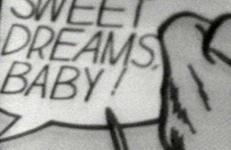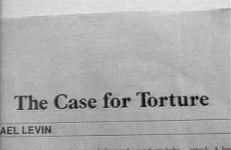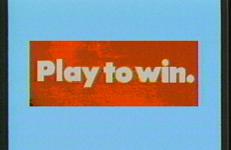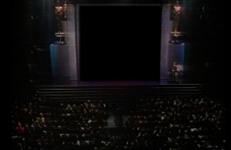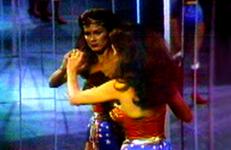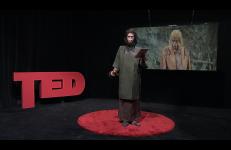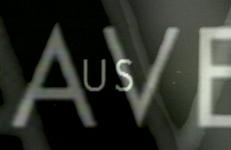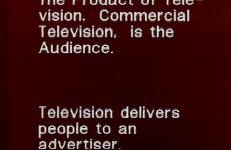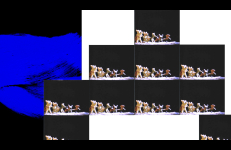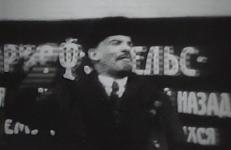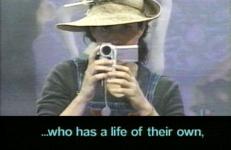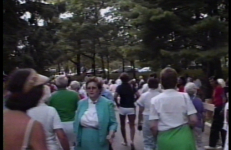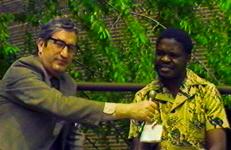"There are three scenes in this work, all reflecting a changing sense of time. Each has a voiceover soundtrack with a similar structure, but with different information. Some of the comments presume that the viewer is privy to information which is never given..."
Media Analysis
Rosler identifies the totalitarian implications of an argument for torture, under certain circumstances, as it appears as a guest editorial in Newsweek magazine in 1982. Her critique is presented as a voiceover and a dizzying assemblage of radio and print media--articles on subjects ranging from human rights to unemployment and global economics. Implicating the U.S.
The Sky Is Falling... is part of an ongoing series of performances that make up The Data Humanization Project.
Slogans is a visual deconstruction of advertising slogans, a literal and metaphorical illustration of the disintegration and loss of meaning in the contemporary media landscape. Appropriating text from a series of familiar print advertisements—Choose Your Weapon, Play To Win, Talk Is Cheap—Muntadas enlarges, digitizes, and overlays words until they devolve into abstract mosaics. Accompanied by a banal muzak soundtrack, this display of text as image demonstrates advertising's insidious transformation of language into empty signifiers.
In turns funny, disturbing, and glisteningly sensual, small lies, Big Truth is a tape about love, relationships, and the joy and banality of sex in the late 20th Century. It also touches on such issues as morality, voyeurism, nature vs. culture, and power, as eight people read fragments from the testimony of William Jefferson Clinton and Monica S. Lewinsky, as published in the Starr Report.
The "dazzling, delightful, and delicious" messages of broadcast television get scrutinzed in Social Studies, Part II: The Academy. Stripped of its glitzy animation and played out against the frozen backdrop of a single spectacular image, the standard Academy Award Ceremony fare of introductions, applause, film-clips, commentary, self promotion, and professional banter shifts the banal mise-en-scene into proto-fascist theater.
Standing on the brink of elimination, the suspense threatening to fracture their composure, contestants wait and see if they will be going home. The audience at home is also waiting... Part two of Bearing Witness Trilogy.
Pirated satellite feeds revealing U.S. media personalities’ contempt for their viewers come full circle in Spin. TV out-takes appropriated from network satellite feeds unravel the tightly-spun fabric of television—a system that silences public debate and enforces the exclusion of anyone outside the pack of journalists, politicians, spin doctors, and televangelists who manufacture the news. Spin moves through the L.A. riots and the floating TV talk-show called the 1992 U.S. presidential election.
St. Marks: New Years Eve combines political commentary with non-narrative segments that celebrate the medium of video. The video’s tonal climax occurs at its beginning, in which a large crowd gathers at a live music event and stands to sing the national anthem with peace signs and middle fingers held high in the air above them.
According to Harun Farocki, today's photographers working in advertising are, in a way, continuing the tradition of 17th century Flemish painters in that they depict objects from everyday life - the "still life". The filmmaker illustrates this intriguing hypothesis with three documentary sequences which show the photographers at work creating a contemporary "still life": a cheese-board, beer glasses and an expensive watch.
In this irreverent and hilarious videotape, renowned street performer Stoney Burke leads us on a subversive tour of the 1992 Republican National Convention in Houston’s Astrodome. Burke disregards the traditional terms of “political debate” offered by the network news establishment, and zeroes in on the questions that never get asked, confronting such Republican luminaries as Oliver North, Neil Bush, Pat Robertson, Jack Kemp, Sen. Alfonse D’Amato, and Rush Limbaugh (among others), on issues that are glossed over during the convention.
An oblique, albeit powerful documentary that examines the current conditions, politics, and economics of South Lebanon. The tape focuses on the social, intellectual, and popular resistance to the Israeli occupation, as well as conceptions of "the land" and culture, and the imperiled identities of the Lebanese people. Simultaneously, the tape self-consciously engages in a critique of the documentary genre and its traditions.
An oblique, albeit powerful documentary that examines the current conditions, politics, and economics of South Lebanon. The tape focuses on the social, intellectual, and popular resistance to the Israeli occupation, as well as conceptions of "the land" and culture, and the imperiled identities of the Lebanese people. Simultaneously, the tape self-consciously engages in a critique of the documentary genre and its traditions.
Parry Teasdale is one of the founding members of the video art collective Videofreex, which was active in the 1960s and 70s. In this extensive two-part interview Teasdale explores the collective’s motivations and endeavors, which embodied the social and political concerns of the period.
A stutter-step progression of "extended moments" unmasks the technological "miracle" of Wonder Woman's transformation, playing psychological transformation off of television product.
"Fusco revives and embodies the chimpanzee animal psychologist Dr. Zira from the original Planet of the Apes films of the late 1960s and early 1970s. In her Skyped-in introduction, esteemed feminist theorist and technoscience philosopher Donna Haraway explains that Dr. Zira narrowly escaped death in the third film and has been living in hiding, observing human behavior through visual culture. In her lecture, Dr.
Holzer adopts the form and language of commercial messages to disrupt communication, presenting kamikaze texts that are designed to stimulate thought, with humor, and inspire a critical attitude in an often passive audience. As in all of Holzer’s work, these television spots present deceptively simple sequences of text that mix provocative social commentary with resonant poetic reflection.
Television Delivers People is a seminal work in the now well-established critique of popular media as an instrument of social control that asserts itself subtly on the populace through “entertainments,” for the benefit of those in power—the corporations that mantain and profit from the status quo. While canned Muzak plays, a scrolling text denounces the corporate masquerade of commercial television to reveal the structure of profit that greases the wheels of the media industry. Television emerges as little more than a insidious sponsor for the corporate engines of the world.
This is our contemporary Mesoamerican temple, restored from an asymmetrical and intermittent grammarchy in motion.
The cabin is on fire! Krystle can't stop crying, Alexis won't stop drinking, and the fabric of existence hangs in the balance, again and again and again. – MR
"The Dark, Krystle brilliantly re-purposes the artificiality of stock gesture, allowing viewers to see its hollowness and to feel it recharging with new emotional power. Equal parts archival fashion show and feminist morality play, Robinson's montage rekindles the unfinished business of identity, consumption, and excess in 1980s pop culture."
— Carrie Secrist Gallery, Chicago
Shot in Lebanon, Syria and Jordan, this essay uses transportation, video, and photography to examine images circulating in a historically charged, and presently war-torn and divided, Middle East. From images of camels in the desert to images of the Arab-Israeli conflict, the video looks at states of mind in relation to actual geographies. The video pays tribute to an unformatted and open-ended documentary approach, and examines modes of access to information such as travel, television and the Internet, while carefully displaying the resulting iconography.
Three Songs of Lenin is an 11-minute piece made from three one-second samples taken from the second song We Loved Him of Vertov's film Three Songs About Lenin. Building on Vertov's second song's structural use of moving and still images to articulate a dynamic of Lenin's passing from life to death, this video employs an algorithmic structure where every other frame is the first frame of the one-second sample. The 29.97 frame rate allows us to almost see moving and still images at the same time as an imagining of Lenin haunting the present.
“Take back the airwaves: Mexico’s video art doyenne Ximena Cuevas books herself onto the tabloid talk show Tombola (Raffle), toying at first with whimsical deconstruction until she turns the whole affair on its head by seizing the televisual flow itself.”
Crowds line the streets for the wedding procession of Caroline Kennedy and Edwin Schlossberg in Hyannis Port, Massachusetts.
Shot and edited by Ligorano Reese
Online editor Rick Feist
Post-production by The Standby Program at Matrix
Addressing the imbalance of information flow between the wealthy and the destitute nations of the world, Towards A New World Information Order suggests means by which this imbalance might be rectified, including ways to control the press.




